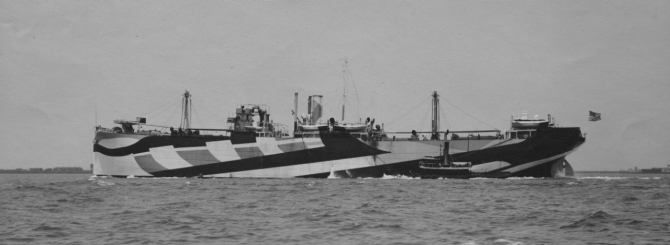Liberator I (Id. No. 3134)
1918-1919

The first Liberator retained the name carried at the time of her acquisition, the second Liberator (AMc-87) was named for the general word classification.
I
(Id. No. 3134: displacement 15,912; length 410'; beam 56'; draft 30'6" (mean); speed 10.5 knots; complement 95; armament none)
The first Liberator -- launched on 24 March 1918 at San Francisco, Calif., by Union Iron Works -- was inspected by the Navy in the Twelfth Naval District on 18 June 1918 with an eye toward her employment as a service collier. Acquired by the Navy on 2 July 1918 and assigned the identification number (Id. No.) 3134, Liberator was commissioned at San Francisco the same day [2 July 1918], Lt Cmdr. Richard Farley, USNRF, in command.
Assigned to the Naval Overseas Transportation Service (NOTS), Liberator transported a cargo of flour to Vallejo, Calif., then sailed from Mare Island on 5 July 1918 for Port Costa. Loading a cargo of army supplies at that port, she sailed on 12 July for the Panama Canal. Proceeding on to New York, the ship reached her destination on 7 August, where she loaded additional cargo, bunkered, underwent voyage repairs, and ultimately cleared New York for France on 13 August. Proceeding in convoy, Liberator reached Brest a little over a fortnight later, on 28 August.
Steaming thence to Paulliac, arriving there on 8 September 1918, Liberator shifted to Verdon-sur-Mer, reaching that destination on 8 October, sailing immediately for New York the same day. Standing in to New York on 22 October, the ship loaded general Army supplies, embarked horses, underwent repairs, bunkered, and sailed for Bordeaux in convoy on 13 November, two days after the Armistice.

Liberator arrived at her destination on 28 November 1918, where she discharged her cargo. She sailed in ballast on 6 December, arriving at New York four days before Christmas of 1918.
Assigned to the Cruiser and Transport Force on 28 December 1918, Liberator underwent alterations at Hoboken, N.J., to enable her to serve as a troop transport, to assist in the return of the American Expeditionary Force to the United States. She sailed on her first trooping voyage on 28 February 1919, setting course for St. Nazaire. Ultimately, she carried out five round-trip voyages between New York and French ports, returning to the former destination on 4 September 1919, where she was turned over to the Commandant, Third Naval District, for disposition.
Decommissioned at Hoboken on 4 October 1919, Liberator was returned to the U.S. Shipping Board on the same day, in whose hands she remained until sold to Lykes Bros.-Ripley Steamship Co., in 1933. She then operated out of Galveston, Tex., until the mid-1940's.
Robert J. Cressman
22 February 2016


